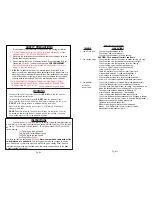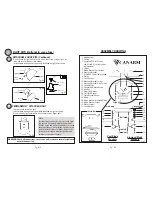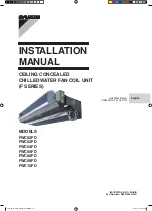
Pg. #2
Pg. #11
INSTRUCTIONS
A ceiling fan has a
completely
internal switching system for total operation by
way of pull
chains.
On a fan/light combination,
pull chains will
exist:
One for light,
on and off. The second is for fan speeds. This will be marked (SPEED) on the fan
switch housing.
1st Pull will give fan High Speed
2nd Pull will give fan Medium Speed
3rd Pull will give fan Low Speed
4th Pull will Shut Fan Off
The third pull chain is for Forwar
d/Reverse#(
Note: Some models come with a slide
switch instead of a pull chain
). This setting would usually be changed
twice
per
year. Downdraft
in
summer to create a wind chill to give a cooling effect. Updraft
in winter to circulate the hot stratified air off the ceiling and back down to the floor
without creating a wind chill.
TROUBLESHOOTING
TROUBLE
SUGGESTIONS
- Check fuses and circuit breakers.
1. Fan will not start - Check wiring connections to fan.
- Check wiring connections in switch housing.
CAUTION: Turn power off for last two items.
2. Fan sounds noisy - Check to make sure that all screws in motor housing are snug.
- Check to make sure that blade bracket screws are tight.
- Check to make sure that marrettes in switch housing
are not rattling against wall of switch housing.
- If fan has a light kit make sure switch housing
screws and set screws are tight.
- Some fan motors are sensitive to signals from solid
state variable controls. If solid state controller is
used, change to an alternative control. (See a
Canarm representative for a list of available controls.)
- Allow a 24 hour break in period to eliminate most noises.
3. Fan wobbles - Check that all blades are screwed firmly into blade brackets.
or shakes
excessively.
- Check that blade brackets are secured firmly to motor.
- Check distance from tip of blades to ceiling. Gently bend up or
down the blade brackets until all distances are the same.
- Check distance between blade tip to blade tip. All
measurements should be equal. Loosen blade
screws and position blade until even then re-tighten.
- Check that the downrod hemisphere notch is engaged in canopy.
- Check to make sure that jam screws in downrod are tightened.
- Make sure canopy and mounting bracket are
tightened securely to wooden joist.
- Make sure warpage has not occurred in wooden
blades. If so, contact the Canarm customer service
department for replacement parts.
SAFETY PRECAUTIONS
1. Turn off power at main electrical service box before starting installation.
2. Electrical connections must comply with local code ordinances, national
electrical codes, CEC, NEC and ANSI/NFPA 70.
3. Make sure the installation site you choose allows the fan blades to rotate
freely without any obstructions.
4. When mounting the fan on a ceiling outlet box, Use an approved (CSA for
Canada and UL for U.S.) ceiling fan box marked "
FOR FAN SUPPORT".
5. WARNING: To reduce the risk of fire, electric shock, or personal injury,
mount fan only to an outlet box marked acceptable for fan support and use
mounting screws provided with the outlet box. Most outlet boxes commonly
used for the support of lighting fixtures are not acceptable for fan support
and may need to be replaced. Consult a qualified electrician if in doubt.
Ensure the outlet box is securely installed in place such that it is able to
support at least the fan weight.
three
6.Total Fan Weight For Reference: 30"approximate 5.0 kgs(11.02lbs),
36"approximate 6.0 kgs(13.23lbs), 42"approximate 7.5 kgs(16.53lbs),
48"approximate 8.0 kgs(17.63lbs), 52"approximate 9.0 kgs(19.84lbs).
WARNING
- To reduce the risk of fire or electrical shock
DO NOT
use this fan with any
solid state speed control device.
- To reduce the risk of personal injury
DO NOT
bend the blade brackets
when installing the brackets, balancing the blades or cleaning the fan. Also,
DO NOT
insert foreign objects in between rotating fan blades.
- Mount with the lowest moving parts at least 2.15 Meters (7 Feet) above
floor or grade level.
-
DO NOT
operate reversing switch while fan blades are in motion. Fan must
be turned off and rotating blades stopped, reverse chain pulled, the speed
chain pulled again to start in the opposite direction.
























